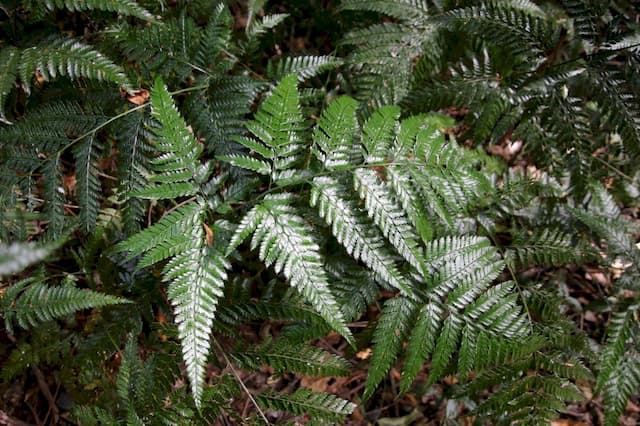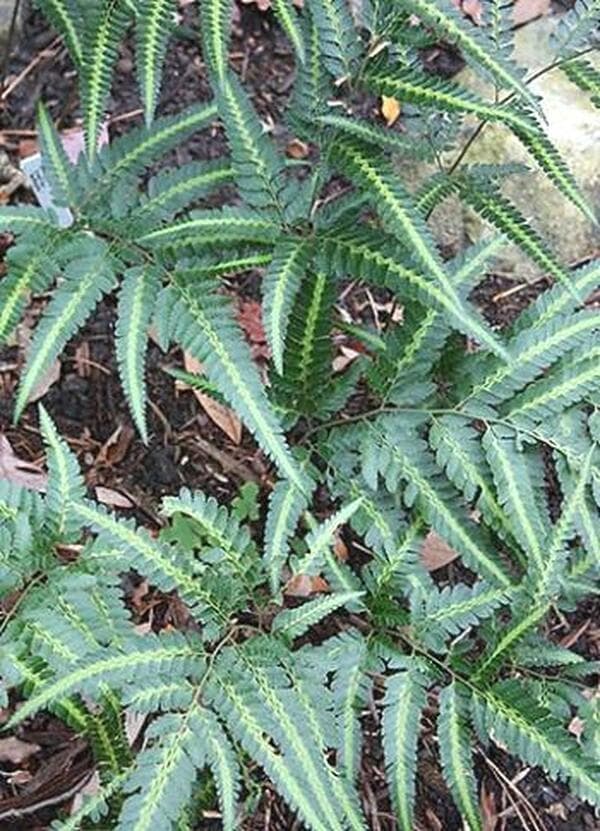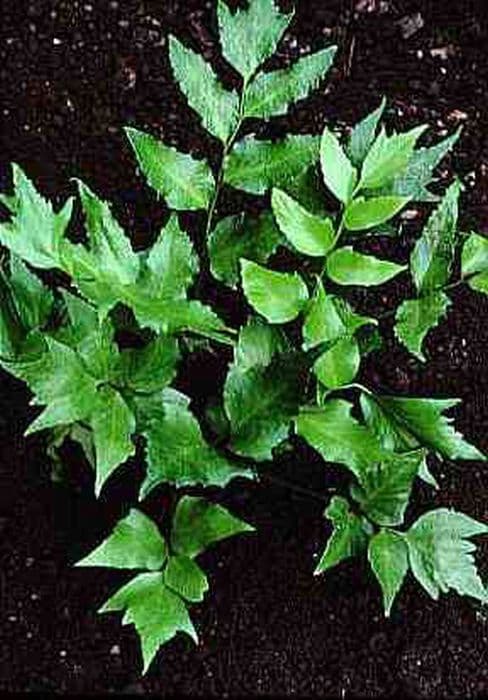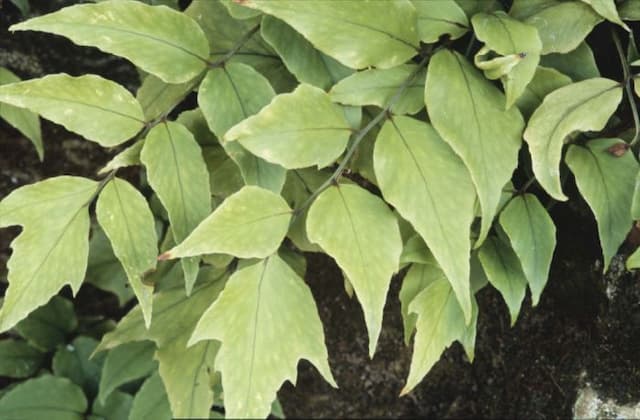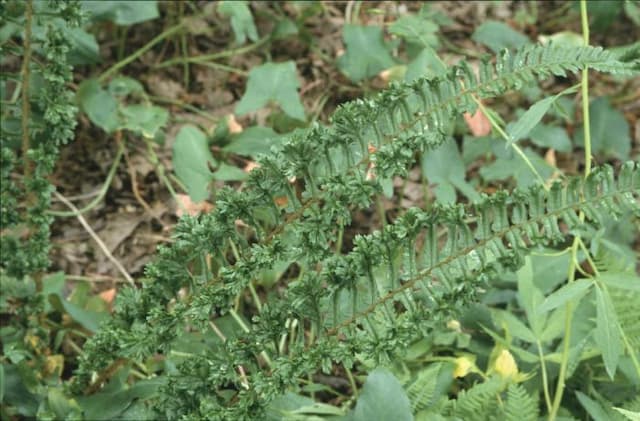Champion's Wood Fern Dryopteris championii

ABOUT
The appearance of Dryopteris championii, commonly known as Champion's wood fern, comprises a beautiful rosette of arching fronds that emanate from a central point, creating a somewhat circular outline. The fronds themselves are elongated, with a dark, glossy green color that can add elegance to shady garden spots. They are compound, meaning they are divided into smaller leaflets, which line the frond's stem in a feather-like arrangement. Each leaflet is further dissected into smaller, toothed sub-leaflets, giving them a delicate, lacy texture. The underside of the leaflets often bears tiny, brown, membranous structures, where the spores are produced. With the lifecycle stages of the plant, these spores can appear dusty, covering the area beneath the fronds. The stems are sturdy and may be slightly scaly or hairy, providing a contrasting texture to the smoothness of the fronds. Champion's wood fern has a natural, woodland charm, making it a lovely addition to shaded garden areas or as an underplanting beneath larger trees and shrubs.
About this plant
 Names
NamesFamily
Dryopteridaceae
Synonyms
Champion's Wood Fern, Narrow Buckler Fern
Common names
Dryopteris championii.
 Toxicity
ToxicityTo humans
Dryopteris championii, commonly known as Champion's wood fern, is not widely known to be toxic to humans. Typically, ferns are not considered dangerously poisonous, and there is limited specific information on the toxicity of this particular species to humans. However, it is always advisable to avoid ingesting parts of any plant not known to be safe for consumption, as they may cause mild stomach upset or allergic reactions in sensitive individuals.
To pets
For Dryopteris championii, also known as Champion's wood fern, there is not much specific information regarding its toxicity to pets. Ferns, in general, are not typically known to be highly toxic to pets, but some can contain compounds that may cause mild gastrointestinal distress if ingested. If a pet were to consume a portion of the Champion's wood fern, symptoms could potentially include vomiting or diarrhea, but severe poisoning is not commonly reported. It is always best to prevent pets from ingesting plants not meant for consumption to avoid any possible adverse effects.
 Characteristics
CharacteristicsLife cycle
Perennials
Foliage type
Evergreen
Color of leaves
Green
Height
2 feet (60 centimeters)
Spread
2 feet (60 centimeters)
Plant type
Fern
Hardiness zones
Varies
Native area
Asia
Benefits
 General Benefits
General Benefits- Ornamental Value: Dryopteris championii, commonly known as Champion's Wood Fern, adds beauty to shade gardens with its lush, green foliage.
- Habitat Support: It can provide shelter and food for various insects and small wildlife in its natural habitat.
- Soil Erosion Control: The root system of Champion's Wood Fern helps to stabilize the soil, preventing erosion in areas where it grows.
- Low Maintenance: Once established, it requires minimal care, making it a convenient choice for gardeners.
- Drought Tolerance: It has the ability to withstand periods of drought once fully established, reducing the need for frequent watering.
- Biodiversity Enhancement: By planting Champion's Wood Fern, gardeners can contribute to the biodiversity of the area, supporting ecological balance.
- Shade Tolerance: This fern thrives in shaded areas where other plants might struggle, providing ground cover and greenery in dim conditions.
 Medical Properties
Medical PropertiesThis plant is not used for medical purposes.
 Air-purifying Qualities
Air-purifying QualitiesThis plant is not specifically known for air purifying qualities.
 Other Uses
Other Uses- As a natural dye: Dryopteris championii can be used for dyeing textiles, providing a range of colors when different mordants are applied.
- Insect repellent: The fern may be used in gardens or crushed and applied to skin or clothing to repel insects, due to certain natural compounds it contains.
- Fern for floral arrangements: The fronds of Dryopteris championii can be included in floral arrangements for their attractive structure and long-lasting nature.
- Mulching material: The fronds can be used as a natural mulch in gardens, aiding in soil moisture retention and weed suppression.
- Craft material: The stems and fronds can be used in crafting, for making wreaths or as part of basket-weaving projects.
- Erosion control: This fern can be planted on slopes or in areas prone to erosion to help stabilize the soil with its root system.
- Shade garden plant: Dryopteris championii is suitable for shade gardens, to add texture and greenery to low-light garden areas.
- Education and research: The species can be used in educational settings for studies in botany and horticulture.
- Terrariums: The fern is suitable for planting in terrariums due to its moderate size and humidity requirements.
- Bioremediation: Certain ferns, including Dryopteris championii, may have a role in bioremediation projects to detoxify soils contaminated with heavy metals or other pollutants.
Interesting Facts
 Feng Shui
Feng ShuiThe Broad Buckler Fern is not used in Feng Shui practice.
 Zodiac Sign Compitability
Zodiac Sign CompitabilityThe Broad Buckler Fern is not used in astrology practice.
 Plant Symbolism
Plant Symbolism- Endurance: Dryopteris championii, commonly known as Broad Buckler Fern, often symbolizes endurance due to its ability to thrive in various environments and withstand changes in climate and seasons.
- Protection: Ferns in general are believed to have protective qualities. As such, the Broad Buckler Fern may represent shelter and safety, harking back to the times when ferns were used to ward off evil spirits.
- Secrecy: Ferns have long been associated with secrets and discretion, possibly owing to their hidden reproductive parts. The Broad Buckler Fern might also carry this symbolic meaning, implying the discretion and the unknown.
- Eternal Youth: Ferns, including the Broad Buckler Fern, are often linked with eternal youth and the search for the mythical "fountain of youth" due to their ancient lineage and lush, green appearance all year round.
 Water
WaterThe champion wood fern should be watered moderately, ensuring the soil remains consistently moist but not waterlogged. Ideally, water the plant with about 1 gallon per watering session for a medium-sized fern, adjusting the volume according to the size of your plant and pot. During the growing season in spring and summer, watering should be done once or twice a week depending on the humidity and temperature of your environment. In the dormant season of fall and winter, reduce watering to every two weeks, but never let the soil dry out completely.
 Light
LightChampion wood fern thrives best in dappled shade or partial sunlight, avoiding direct afternoon sun which can scorch its fronds. The ideal spot for this plant would be a north-facing window or a location that gets filtered light through a sheer curtain. Bright indirect light will also support healthy growth without the risks associated with intense direct sunlight.
 Temperature
TemperatureChampion wood fern prefers a cool to moderate temperature range, typically between 60 and 75 degrees Fahrenheit. It can tolerate a minimum temperature of around 50 degrees Fahrenheit, but should not be subjected to temperatures below that as it may damage the fronds. The fern should be protected from drafts and sudden temperature changes to maintain its health.
 Pruning
PruningPruning champion wood fern is usually done to remove dead or damaged fronds and to maintain a tidy appearance. Prune in the spring just before the new growth begins, using clean and sharp tools to avoid damaging the healthy parts of the plant. It is not necessary to prune frequently; once a year or as needed should suffice to keep your fern looking its best.
 Cleaning
CleaningAs needed
 Soil
SoilThe best soil mix for the Champion's Wood Fern should be rich, well-draining, and consistently moist. A blend of garden soil, peat, and perlite or sand can provide this balance. The pH should be slightly acidic to neutral, ranging from 6.0 to 7.0.
 Repotting
RepottingChampion's Wood Fern should be repotted every 2-3 years to refresh the soil and accommodate growth. Repotting is best done in the spring, just before new growth begins.
 Humidity & Misting
Humidity & MistingChampion's Wood Fern thrives in high humidity conditions, preferable around 60% to 70%. It will benefit from regular misting or a humidifier in dry environments.
 Suitable locations
Suitable locationsIndoor
Provide bright, indirect light and maintain high humidity.
Outdoor
Plant in shady area with moist, well-draining soil.
Hardiness zone
5-8 USDA
 Life cycle
Life cycleThe Champion's Wood Fern (Dryopteris championii) begins its life cycle when spores located on the underside of mature fronds are released into the environment. These spores, upon landing in suitable moist and shaded conditions, germinate to form a small, heart-shaped gametophyte known as a prothallus. The prothallus houses both male and female reproductive organs, which, upon maturation, allow for fertilization, and subsequently the development of a zygote. The zygote then grows into a new sporophyte, marking the transition to the next generation of fern. As the sporophyte matures, it develops roots, a rhizome, and fronds, completing the vegetative structure of the fern. With maturity, the fronds start to produce spores on their undersurface, and the cycle resumes with spore release, perpetuating the life stages of the Champion's Wood Fern.
 Propogation
PropogationPropogation time
Spring to Summer
Propogation: The most popular method of propagating the Dryopteris championii, commonly known as Champion's Wood Fern, is through spore collection and sowing. To do this, mature fronds with ripe spores are collected during late summer when the spores are ready to be released. The spores must be sown on the surface of a sterilized, moistened propagation medium, such as a peat and perlite mixture, or finely milled sphagnum moss. This medium should be contained in a clear, sealed container to maintain humidity, which is essential for spore germination. The container is then placed in a warm area with indirect light. Germination can take several weeks to months, and once the sporelings are large enough, they can be transferred to individual pots to grow on into mature ferns. This method requires patience and attention to environmental conditions, including temperature and moisture levels.
